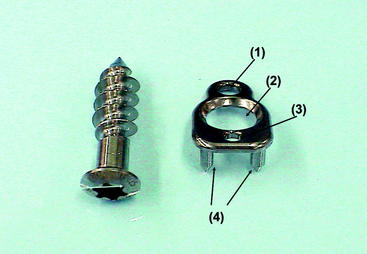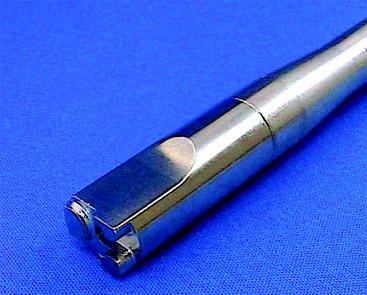Chapter 44 Double-Spike Plate
Cortical Fixation Device Enabling Graft Fixation Under Optional Tension
Background and Basic Concept
The pullout technique by tying sutures around a screw post or over a button is commonly used as a stand-alone fixation or as an augmentation for interference screw fixation into a tibial bone tunnel in the final stage of anterior cruciate ligament (ACL) or other ligament reconstruction. As the step of tensioning cannot be separated from that of fixation in this technique, the following problems have remained unsolved: loosening or breakage of the sutures while tying sutures around a post1 and difficulty in correctly controlling the tension to the graft.2 In order to solve these problems, a fixation device, the double-spike plate (DSP) (Ref. 020A-004, MEIRA Corp., Nagoya, Aichi, Japan) was developed to separate the step of tensioning from that of fixation.1 This device is currently commercially-sold only in Japan by Smith & Nephew Japan but will be shortly launched into the world market.
Specifications and Instruments for Use
The DSP is a small plate made of titanium alloy with three holes and two spikes on the reverse side (Fig. 44-1). There are two sizes available: the standard DSP for big knee or single tunnel reconstruction (11 mm wide × 18 mm long × 1.5 mm thick with two spikes of 5.5 mm length) to be used with a 6.5-mm screw and the small DSP for a small knee or double-bundle procedure (8.5 mm wide × 13.8 mm long × 1.5 mm thick with spikes of 4.2 mm length) to be used with a 5-mm screw (see Fig. 44-1). The impactor is available for securely hammering base spikes into the cortical bone (Fig. 44-2). The centering drill guide is also available for creating a screw hole.
Rationale for Maintaining the Tension During Graft Fixation to the Tibia
If the top end of the DSP closely keeps in close contact with the tibial cortex without movement, the DSP should show hinge motion around its top in the sagittal plain while its spikes are hammered into the tibia (Fig. 44-3). Thus the prehammering tension of the graft suture that has already been tied to the top hole could be assumed to be equal to its post-hammering tension. Although there is an instant increase of the tension due to minimal distal movement of the plate when the base spikes are hammered into the cortex, the tension goes down almost to the predetermined level after load relaxation for a minute or two (Fig. 44-4).
Stay updated, free articles. Join our Telegram channel

Full access? Get Clinical Tree










